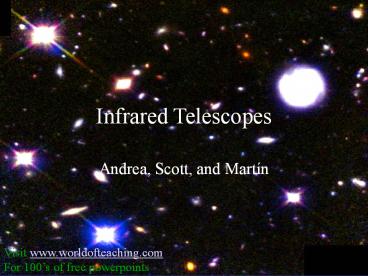Infrared Telescopes - PowerPoint PPT Presentation
Title:
Infrared Telescopes
Description:
In 1980's the military dedicated the first large sum of money towards infrared ... Largest telescope put in an aircraft. UKIRT. Earth-based. Largest infrared telescope ... – PowerPoint PPT presentation
Number of Views:297
Avg rating:3.0/5.0
Title: Infrared Telescopes
1
Infrared Telescopes
- Andrea, Scott, and Martín
Visit www.worldofteaching.com For 100s of free
powerpoints
2
Infraredwait what?!?!?
- Infrared is a certain region in the light
spectrum - Ranges from .7µ to 1000µ or .1mm
- Broken into near, mid, and far infrared
- One step up on the light spectrum from visible
light - Measure of heat
3
Infrared Telescopes
- Infrared telescopes work much like visible light
telescopes - Light hits parabolic mirror
- Light is sent to focal point
- Light is recorded by computer and translated into
visible light
4
History of Infrared
- Thirty years ago images were created by crude
temperature readings and simple recording devices - In 1980s the military dedicated the first large
sum of money towards infrared advancement (high
background infrared) - Recently scientists have changed the technology
to focus on lower background heat and high
sensitivity to fit the applications needed for
astronomy
5
Problems with Infrared
- 99 of infrared rays are absorbed by water in our
atmosphere - The use of airplanes, weather balloons, and space
bound telescopes help to solve these problems
Infrared
6
Another Problemo
- Everything in the universe above absolute zero
radiates heat (infrared) - This means the heat from the telescope may
interfere with data - Everything is cooled to almost absolute 0
7
Why Do We Need Infrared Telescopes?
- Infrared telescopes allow astronomers to gain
information about regions in space that might
otherwise remain invisible.
http//coolcosmos.ipac.caltech.edu/cosmic_classroo
m/ir_tutorial/psc_allsky.html
8
These regions include
- Cool states of matter
- Regions obscured by clouds of dust or gas
particles
http//coolcosmos.ipac.caltech.edu/cosmic_classroo
m/ir_tutorial/animation.html
9
Cool States of Matter
- Most solid bodies in space vary in temperature
from 3 Kelvins to 1500 Kelvin's. - This means that extremely cool objects
undetectable to the human eye can be studied
using infrared telescopes. - These can include
http//www.spitzer.caltech.edu/picturegallery/inde
x.shtml
10
- Stars
- Infrared galaxies
- Clouds of particles around stars
- Nebulae
- Interstellar molecules
- Brown dwarfs
- Planets
http//www.iras.ucalgary.ca/volk/crab_infrared_lg
.gif
http//swtrekking.com/photo_gallery/images/stars.j
pg
http//www.astr.tohoku.ac.jp/tohru/AGgroup/arp220
image.jpg
http//map.gsfc.nasa.gov/ContentMedia/M16WF2.jpg
11
Clouds of Dust and Gas
- Some bodies of matter in space are hidden behind
huge clouds of dust particles or gas.
- Infrared telescopes allow scientists to view
these regions much more easily
- These include the centers of galaxies and clouds
containing forming stars and planets.
12
The Early Universe
- The Universe is constantly expanding
- Because of this, most of the radiation emitted
from distant stars is in the infrared spectrum. - Our views of these distant bodies of matter in
space actually show us how they looked a long,
long time ago.
http//coolcosmos.ipac.caltech.edu/cosmic_classroo
m/cosmic_reference/redshift.html
13
- To gain a greater knowledge about bodies of
matter in space, we need information about all of
the different forms of radiation that they emit.
14
SOFIA
- Airborne Observatory
- Reduces Atmospheric Interference
- Will begin observing in 2005
15
SOFIA
- 747SP Aircraft
- 2.5 meter reflector
- Largest telescope put in an aircraft
16
UKIRT
- Earth-based
- Largest infrared telescope
- Located on Mauna Kea in Hawaii
- 3.8 meter reflector
- A lot of atmospheric interference
17
Spitzer Space Telescope
- Largest infrared telescope in space
- No atmospheric interference
- .85 m reflector
- Cryogenically cooled so not to interfere with
signals
18
Spitzers Cryostat
- Infrared is mostly heat waves, Spitzer is cool so
its own heat does not interfere with signals - 1.4 degrees kelvin
19
Spitzer Images
20
Bibliography
- http//www.sofia.arc.nasa.gov/Sofia/sofia.html
- http//www.spitzer.caltech.edu/about/index.shtml
- http//www.jach.hawaii.edu/JACpublic/UKIRT/home.ht
ml






























